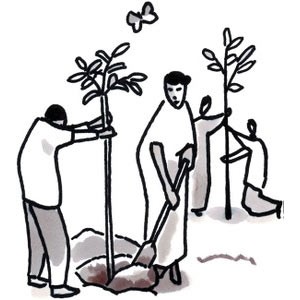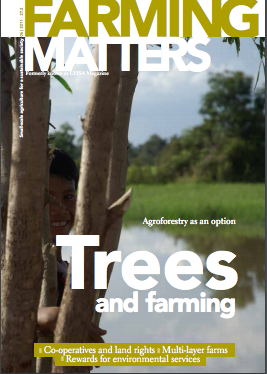“Agriculture is sustainable if it can attract future generations of young farmers”. These were the words that Edith van Walsum, ILEIA’s director, used to open the editorial in our previous issue. A similar idea lies behind The Green Wave, an initiative of the Convention on Biological Diversity. This is an international campaign involving schools in more than 70 countries, the aim of which is to raise awareness around the importance of biodiversity among children and youth.

The Green Wave campaign has contributed significantly to the annual celebration held on the 22nd of May, the day proclaimed by the UN as the International Day for Biological Diversity. Taking part in it is easy and fun. As the Executive Secretary of the UN Convention on Biological Diversity, Ahmed Djoghlaf, explains, “we have kept the project simple and adaptable to enable the participation of as many schools and young people as possible around the world.
Teachers have access to a series of resources and guiding instructions on the Green Wave website. They are welcome to create their own projects and/or integrate biodiversity components in their existing curricula”.
This year’s theme, reflecting the International Year of Forests, was forest biodiversity. As always, participants were requested to count down to 10:00 a.m. local time, when they planted a locally important tree species. Wherever this was not possible, for example because of climatic reasons, students could still participate in the event by watering the trees in their schoolyard, or by taking another action to support trees and forests. Each single action contributed to the creation of a figurative “green wave” travelling west around the world.
The Convention on Biological Diversity aims to conserve biodiversity, ensuring the sustainable use of biodiversity and enabling the fair and equitable sharing of benefits arising from this. To know more about the Convention you can visit its website: http://www.cbd.int. In 2012 the theme of The Green Wave will reflect the importance of marine and coastal biodiversity.
All the information and instructions for teachers and students interested in taking part are available (in English French, Japanese and Spanish) at The Green Wave website: http://greenwave.cbd.int.
Why planting trees? “In terms of learning”, according to Dr Djoghlaf, “what better than a tree to demonstrate the interconnectedness of species and ecosystems? A growing tree represents a microcosm of biodiversity, a micro-ecosystem in itself – sustaining life in the soil and the roots, in the bark, leaves, flowers and branches – microscopic organisms, fungi, plants and animals of all kinds… There is so much there to observe and study!” “Moreover,” he continued, “there is something fascinating and intrinsically attractive about planting trees. There is strength in the idea of giving and sustaining life – and in particular to something that could live and grow for centuries.” The idea of co-operation, working together to make a big difference, is another key aspect of the campaign.
The promoters’ hope that participants will associate caring for nature with the real pleasures of discovery, sharing and giving something back. “We also hope that they enjoy working together as a group, and as part of a worldwide movement. They get a chance to be part of a global community of young people who care for the planet and co-operate, beyond borders, to safeguard the well-being of humanity”.
Text: Nicola Piras
Illustration: Fred Geven

